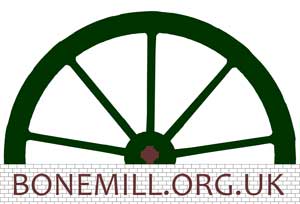The processes for grinding flint and bones are essentially the same. Bones would have been boiled first to remove tissue, this would in turn produce glue which could be sold as a by-product. The bones would then be moved to the calcining kiln where wood was used as fuel, not coal as would be used with flints, as bone is more combustible and prone to contamination from iron pyrites in coal. Calcinated bone becomes softer and whiter than in its natural state. The calcining kiln would have consisted of two chambers with a hovel built above them to create a draught to aid combustion. Filling the kiln was a very skilled job requiring layering of fuel and either bone or flint. Bones would be built up in layers with wood. It would be allowed to combust for 8 to 16 hours (depending on the fuel and climatic conditions) and then left to cool before being withdrawn through draw holes at the bottom. The kiln would be first heated up to 1000 centigrade, this softened the bones and made them easier to grind. Filling the kilns was a specialised task requiring careful laying of wood at the bottom and alternate layers of fuel and bone. Bone would require, because of its organic nature, little fuel once combustion had commenced and could be calcined more quickly than flint. After calcining and cooking for up to at least 8 hours the bones were then cooled enough to handle and the kiln would be hand drawn from the bottom. Any impurities would be removed, and any large bones would be cracked by hammers and or passed through a jaw cracker. The material would be taken to the pan room and tipped into the pan. These would be circular of around 12 ft in diameter with vertical sides about 3ft high. The floor of the pan would be carefully built up of chert blocks on a clay seal. A vertical shaft went through the centre of the pan for the gear drive below. The shaft would normally have 4 arms which carried vertical handing timbers. After this process any fat remaining with the one slop caused a froth and this had to be skimmed off. Following this the mixture was passed into a washtub. This would be repeated until all the sediment was at the bottom. The mixture would then be drained off so the sediment could be dried and removed in blocks.
Some millers would purchase bones ready prepared for calcining to avoid the threat of diseases such as anthrax. Many mills would boil the bones themselves with glue being a saleable by-product. Local bones would have been purchased early on in the industry, but then they would be imported from India, Pakistan, Egypt and China. Cattle bones are most preferable as shin bones tend to have a high mineral content and horse bones give the ware a greenish hue. Some millers would tell stories of human bones being included in consignments and various whale and elephant bones have been saved from the grinding process. Grinding would have been done either in pans (wet pan grinding), or with stamps raised by cams and allowed to fall under gravity onto the bones being processed (this was soon discouraged due to the dust it created, causing silicosis) or a set of edge runners or even millstones.
Source: Mills Trust Research 2015
History of the Bone Mill Model Mill Boiling House



